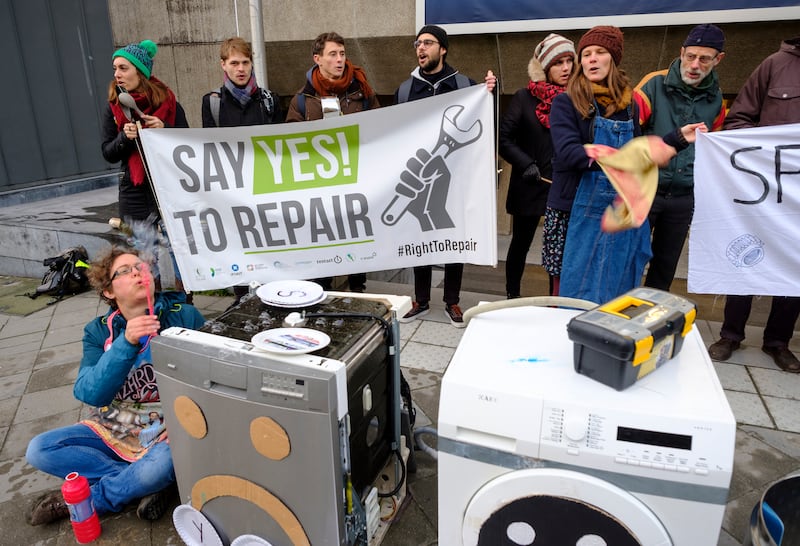Smart devices and appliances are those with an internet connection, anything from a fitness tracker or printer to a television or washing machine. Most households have smart devices – they’re increasingly not a choice, but a default. In some categories, such as TVs, you’d have struggled in recent years to find anything that isn’t ‘smart’, whether you wanted it or not.
But research by UK consumer advocates Which? indicates that support for smart devices and appliances may only be supplied for as little as two years (that’s the minimum under EU regulations), even for an item as costly as a new dishwasher. This was the case with an LG ‘smart’ model even though, Which? notes, smart appliances that provide additional features can cost far more – around €300 extra.
While large smart appliances can be run from the machine’s control panel, they also can be controlled with apps. Extra features such as specialised wash cycles can be downloaded to the machine, or it can assess the most efficient programme for a load of dishes or laundry. Basic problems can be diagnosed and even repaired via the app.
To pay a premium for such features but lose the ability to access them within a few years is ridiculous. Worse, this process isn’t obvious to consumers who making the logical assumption that an expensive ‘smart’ purchase will remain smart for its operational lifespan.
And then there’s the negative environmental impact when items lose key smart features and software support years before they’d otherwise be replaced. With large appliances, that means more go to landfill when otherwise functional. Smaller digital devices also have significant environmental impacts, and should be used as long as possible.
But Which? found that manufacturers did little to highlight their products’ short smart lives. LG currently offers just two years of guaranteed support for TVs, dishwashers and washing machines despite estimated lifespans of 13, 11 and seven years respectively. Sony supports its smart TVs for only two years, and Samsung for just three. HP printers get a mere three years of support, though an inkjet printer should last up to 13 years.
Which? approached 119 brands about hundreds of smart device products, across 20 different categories, but by late last year only 49 per cent replied with clear information on support periods. Major brands such as AEG, Apple, Epson, Hoover and Whirlpool didn’t respond at all.
My own experience with smart has been discouraging. I’ve had a smart washing machine for a few years, though I bought it on the basis of good reviews, not its additional smart elements, none of which have proven to be smart at all.
It came with an app that initially was only available for Android handsets (an important point that wasn’t made explicit), but we’re an iPhone household. I wasn’t about to buy a handset just to download an exotic wash programme that wasn’t one of the 13 already available directly on the machine’s dial. Of those, only three get used regularly anyway.
However, not having the basic fault diagnostics ability was irritating and when, after a couple of years, an iPhone version of the app became available, I downloaded it – only to find it wouldn’t work because my machine didn’t seem to be supported any longer. Those exasperating shortcomings are among the issues Which? highlights.
Which? is campaigning for legislative change in the UK to require more clarity on product lifespans for smart products and the term of software support. In the EU, changes are coming, primarily through proposed initiatives under the EU’s New Consumer Agenda, part of the Circular Economy Action Plan and a follow-on to the European Green Deal. These aim to address built-in product obsolescence that pushes consumers to replace working products, and will require products to be repairable. Manufacturers will also need to be clearer on how long a product is supported, a badly-needed improvement for smart products.

[ Sustainability means an end to take, make and wasteOpens in new window ]
“The issue of unrepairable phones and laptops, which triggered a lot of the legislative revisions, became more prominent during the pandemic when shortages of supplies, combined with increased demand, exacerbated the problem, which is, of course, a global issue,” a spokeswoman for the EU’s European Consumer Centre Ireland told me.
However, even with regulatory change, many smart devices will still have a basic shortcoming: software capability outpacing the existing hardware.
“The main issue in terms of technology is that smart devices’ software updates more frequently than the hardware, and consumers will sometimes find that the new software updates are not supported by older hardware or that devices do not behave optimally in terms of functionality after the latest software update,” the spokeswoman said.
That means that while consumers will have to be informed about a smart device’s smart lifespan – a welcome change – its smart obsolescence often will remain. Surely this is untenable, and encourages some of the worst kinds of waste: huge appliances and toxin-containing digital devices. For now, smart appears pretty dumb.






